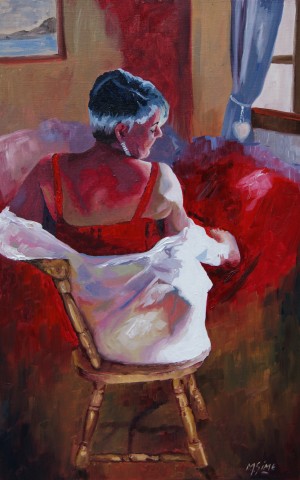Understanding Composition and Color in Figurative Oil Painting
Understanding Composition and Color in Figurative Oil Painting
Blog Article
The Role of Emotion and Expression in Figurative Oil Paint: An In-Depth Evaluation of Subject Matter and Composition
The interplay of feeling and expression in metaphorical oil painting serves as a critical lens through which one can examine the elaborate relationship between subject matter and composition. Artists harness various techniques, from color choice to brushstroke dynamics, to cultivate psychological resonance within their jobs.
Understanding Emotion in Art
Feeling in art offers as an effective conduit for expression, enabling musicians to communicate intricate sensations via their work. In figurative oil paint, this emotional depth is often represented with the representation of the human number, recording the subtleties of human experience. The selection of topic, color combination, and brushwork all add to the psychological resonance of a piece.
Artists often attract upon individual experiences, social issues, or global motifs to stimulate feelings in the audience. For example, a picture may show vulnerability, while a vibrant figure in movement can represent freedom or turmoil. These psychological strings connect the customer to the artwork, cultivating a dialogue that transcends the aesthetic medium.
Additionally, the interplay between light and darkness can intensify emotional strength, leading the viewer's gaze and accentuating certain aspects within the make-up. Making use of texture in oil paint even more includes layers of intricacy, inviting a tactile response that enhances the psychological experience. Overall, comprehending emotion in art is vital for appreciating the subtleties that identify figurative oil paint, as it transforms plain representation into an extensive exploration of the human condition.
Crucial Element of Composition
In the world of metaphorical oil paint, the make-up works as the underlying structure that arranges visual components and enhances the psychological story. Important parts of make-up consist of equilibrium, contrast, focal factor, and rhythm, each adding to the overall influence of the art work.
Balance refers to the distribution of visual weight within the painting, which can be achieved with asymmetrical or in proportion plans. A well-balanced composition offers stability, allowing the visitor to involve with the item sympathetically - figurative oil painting. Comparison, on the various other hand, includes comparing different elements, such as light and dark or cozy and awesome colors, to lead the visitor's eye and evoke psychological feedbacks
The focal point is critical, as it routes focus to the most considerable component of the paint, typically highlighting the psychological core of the story. By skillfully incorporating these key components, artists can craft mentally resonant and compelling metaphorical oil paints that astound and involve their target market.
Topic Issue and Its Impact
Subject plays a critical function in figurative oil paint, as it not just works as the structure for the story yet also shapes the viewer's analysis and psychological involvement with the artwork. The choice of topic-- be it a singular number, a group dynamic, or a thematic representation-- directly affects the psychological environment conveyed to the audience.

As an example, pictures usually evoke individual connections, disclosing the ins and outs of human expression and personality, while scenes illustrating communal tasks can create a feeling of belonging or nostalgia. Moreover, the cultural and historic context of the topic enhances the visitor's understanding, prompting much deeper reflections on social norms, values, and the human problem.
Various subject matters likewise create varying levels of involvement; a dramatic dispute shown through figures in stress might elicit feelings of anxiousness or compassion, while peaceful landscapes can invoke peace and consideration. Eventually, the influence of subject in metaphorical oil paint is profound, as it serves as an avenue for emotional resonance, directing the visitor's reaction and interpretation, and cultivating a link between the viewer and the art work. This interplay is necessary for the effective interaction of the musician's intent.
Techniques for Evoking Feelings
The effectiveness of figurative oil painting in conveying emotions is considerably influenced by the methods utilized by the artist. One of the most crucial techniques is using shade concept, where the calculated choice of colors can stimulate certain psychological actions. Cozy colors, such as reds and oranges, typically generate feelings of passion or aggression, while cooler tones like blues and greens often tend to stimulate peace or despair.
An additional necessary strategy is the adjustment of light and darkness, referred to as chiaroscuro. This technique enhances the three-dimensionality of figures, producing dramatic contrasts that can heighten emotional depth. The placement of light can direct audiences' emotions, highlighting specific components of the make-up.
Brushwork additionally plays an essential role; loose, expressive strokes can share power and spontaneity, whereas smoother methods may suggest harmony or precision. The arrangement of topics within the structure can influence emotional impact. Close closeness can suggest intimacy, while distance may show seclusion.
Ultimately, the mix of these methods enables artists to craft narratives that resonate with the audience, transforming a mere aesthetic experience into an evocative psychological journey. - figurative oil painting

Case Research Studies of Notable Works
Checking out noteworthy jobs of metaphorical oil painting reveals exactly how numerous techniques are utilized to stimulate powerful feelings. One excellent situation is Edvard Munch's "The Scream," where the altered figure and swirling history share existential dread. Munch's usage of color-- dazzling oranges and deep blues-- intensifies the psychological impact, showcasing exactly how palette selections can shape viewer experience.
Another considerable job is Pablo Picasso's "Les Demoiselles d'Avignon." Right here, fragmented forms and bold brushstrokes show a troubled psychological landscape, testing standard depictions of the female figure. Picasso's innovative composition not only records the viewer's focus yet additionally welcomes reflection on motifs of identity and sexuality.
In Addition, Frida Kahlo's "The Two Fridas" provides a poignant expedition of visit our website duality and self-identity. The different figures, linked by a common heart, exhibit Kahlo's emotional depth and individual story. figurative oil painting. Her meticulous interest to detail and symbolic aspects serve to involve audiences on a visceral degree
These study underscore the extensive connection in between feeling and composition in metaphorical oil painting, revealing exactly how artists harness strategy to interact complex sensations and narratives that reverberate across time and culture.

Conclusion
Finally, the interplay of feeling and expression in figurative oil paint significantly improves the viewer's experience and analysis of the artwork. With a mindful choice of subject and compositional methods, musicians communicate extensive narratives that reverberate on both personal and global levels. The application of shade brushwork, chiaroscuro, and theory more magnifies emotional depth, more tips here changing each canvas into an effective reflection of the complexities of the human experience.
In figurative oil paint, this psychological depth is often depicted through the representation of the human number, capturing the subtleties of human experience.Furthermore, the interplay in between light and darkness can intensify emotional intensity, directing the customer's stare and attracting focus to particular elements within the make-up. The usage of structure in oil paint even more includes layers of complexity, welcoming a responsive response that boosts the emotional experience.The focal factor is crucial, as it routes interest to the most significant component of the painting, typically highlighting the emotional core of the narrative. Eventually, the influence of subject matter in figurative oil painting is extensive, as it serves as a channel for psychological vibration, directing the audience's response home and interpretation, and promoting a connection between the art work and the viewer.
Report this page